E-Commerce: Factors Influencing Online E-Shopper Satisfaction in China
VerifiedAdded on 2022/11/18
|67
|20565
|268
Project
AI Summary
This project provides an empirical study of the factors influencing online e-shopper satisfaction in China's first-tier cities. It begins with an introduction outlining the background, problem statement, research aim, objectives, questions, and hypotheses. The literature review explores e-commerce shopping, factors affecting online shopping, customer satisfaction, and a conceptual framework. The research methodology details the research outline, philosophy, approach, design, strategy, sampling procedures, data collection, and analysis methods, alongside ethical considerations. Findings are presented through descriptive and inferential statistics, including correlation, regression, and factor analyses, testing the research hypotheses. The analysis and results section discusses the findings and their implications. The conclusion links back to the objectives, acknowledges limitations, suggests future scope, and provides recommendations for firms in China to improve e-commerce customer satisfaction.
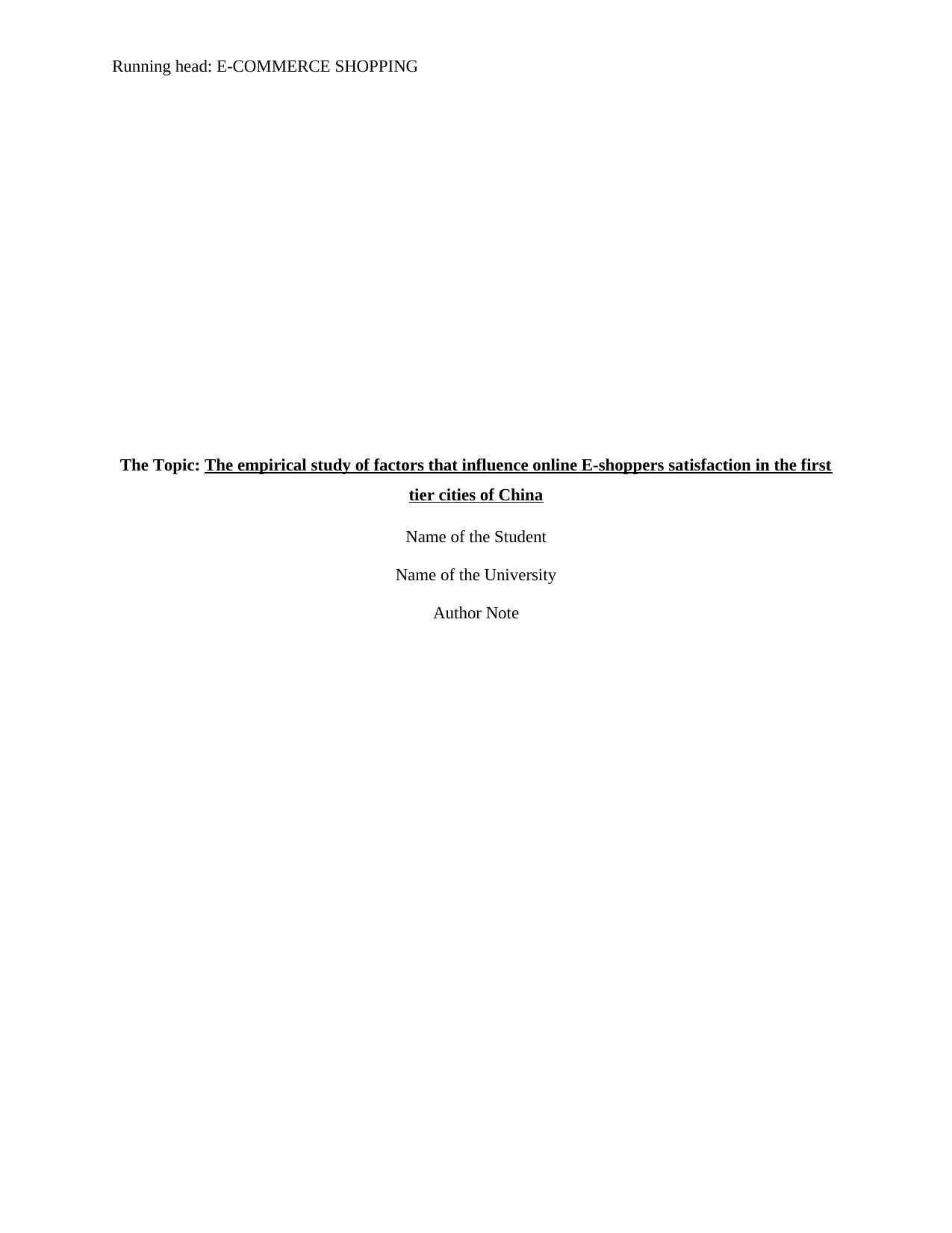
Running head: E-COMMERCE SHOPPING
The Topic: The empirical study of factors that influence online E-shoppers satisfaction in the first
tier cities of China
Name of the Student
Name of the University
Author Note
The Topic: The empirical study of factors that influence online E-shoppers satisfaction in the first
tier cities of China
Name of the Student
Name of the University
Author Note
Paraphrase This Document
Need a fresh take? Get an instant paraphrase of this document with our AI Paraphraser
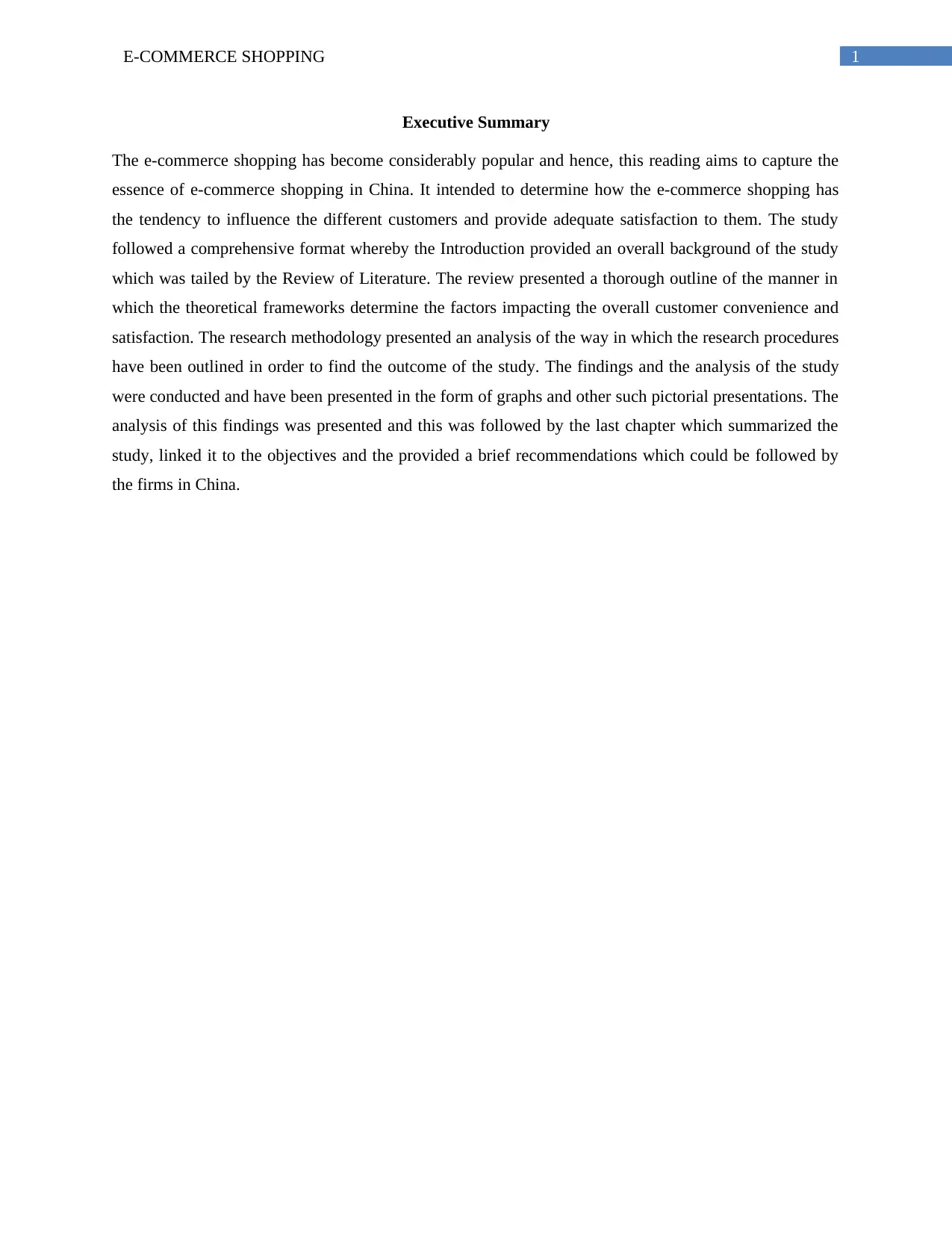
1E-COMMERCE SHOPPING
Executive Summary
The e-commerce shopping has become considerably popular and hence, this reading aims to capture the
essence of e-commerce shopping in China. It intended to determine how the e-commerce shopping has
the tendency to influence the different customers and provide adequate satisfaction to them. The study
followed a comprehensive format whereby the Introduction provided an overall background of the study
which was tailed by the Review of Literature. The review presented a thorough outline of the manner in
which the theoretical frameworks determine the factors impacting the overall customer convenience and
satisfaction. The research methodology presented an analysis of the way in which the research procedures
have been outlined in order to find the outcome of the study. The findings and the analysis of the study
were conducted and have been presented in the form of graphs and other such pictorial presentations. The
analysis of this findings was presented and this was followed by the last chapter which summarized the
study, linked it to the objectives and the provided a brief recommendations which could be followed by
the firms in China.
Executive Summary
The e-commerce shopping has become considerably popular and hence, this reading aims to capture the
essence of e-commerce shopping in China. It intended to determine how the e-commerce shopping has
the tendency to influence the different customers and provide adequate satisfaction to them. The study
followed a comprehensive format whereby the Introduction provided an overall background of the study
which was tailed by the Review of Literature. The review presented a thorough outline of the manner in
which the theoretical frameworks determine the factors impacting the overall customer convenience and
satisfaction. The research methodology presented an analysis of the way in which the research procedures
have been outlined in order to find the outcome of the study. The findings and the analysis of the study
were conducted and have been presented in the form of graphs and other such pictorial presentations. The
analysis of this findings was presented and this was followed by the last chapter which summarized the
study, linked it to the objectives and the provided a brief recommendations which could be followed by
the firms in China.
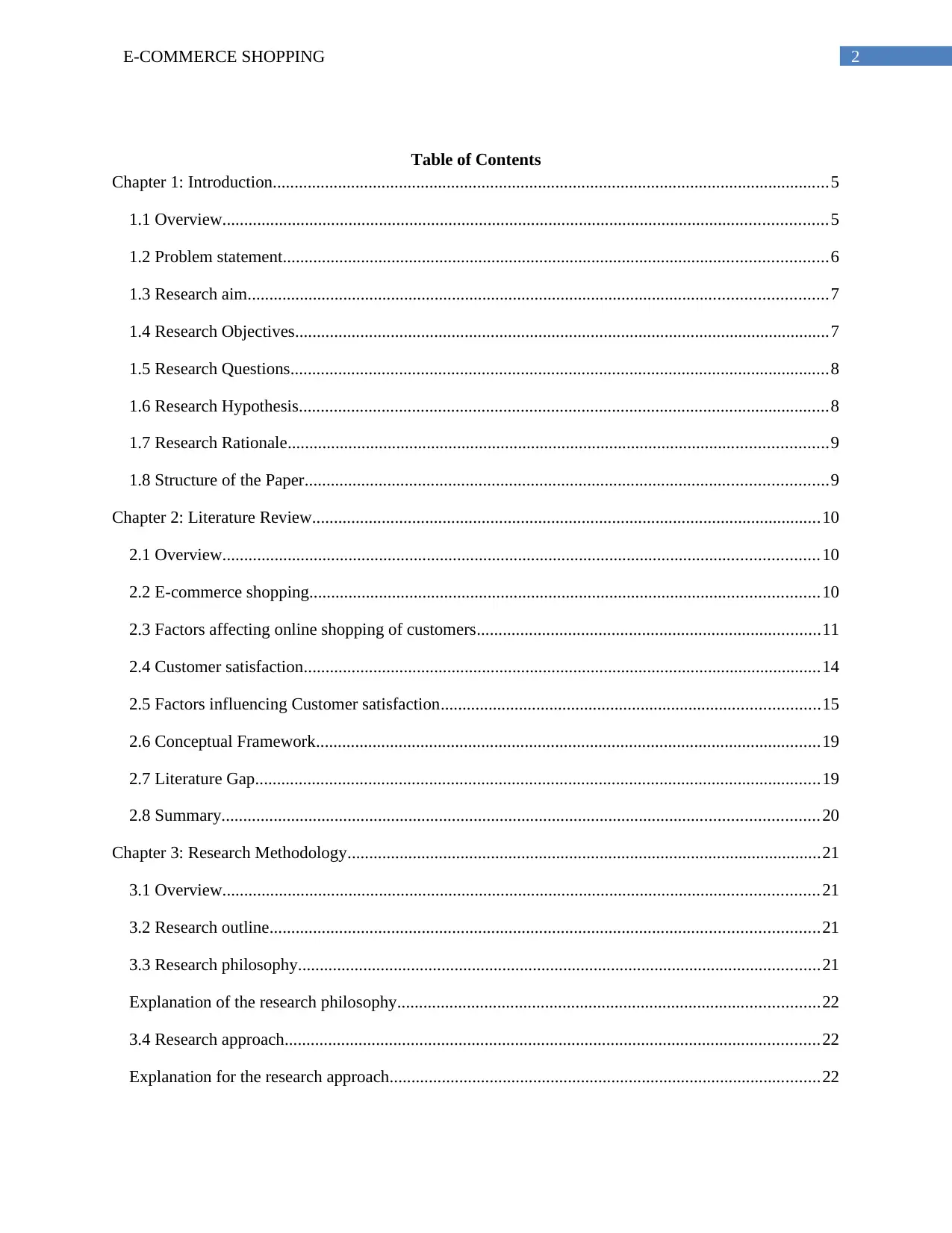
2E-COMMERCE SHOPPING
Table of Contents
Chapter 1: Introduction................................................................................................................................5
1.1 Overview...........................................................................................................................................5
1.2 Problem statement.............................................................................................................................6
1.3 Research aim.....................................................................................................................................7
1.4 Research Objectives...........................................................................................................................7
1.5 Research Questions............................................................................................................................8
1.6 Research Hypothesis..........................................................................................................................8
1.7 Research Rationale............................................................................................................................9
1.8 Structure of the Paper........................................................................................................................9
Chapter 2: Literature Review.....................................................................................................................10
2.1 Overview.........................................................................................................................................10
2.2 E-commerce shopping.....................................................................................................................10
2.3 Factors affecting online shopping of customers...............................................................................11
2.4 Customer satisfaction.......................................................................................................................14
2.5 Factors influencing Customer satisfaction.......................................................................................15
2.6 Conceptual Framework....................................................................................................................19
2.7 Literature Gap..................................................................................................................................19
2.8 Summary.........................................................................................................................................20
Chapter 3: Research Methodology.............................................................................................................21
3.1 Overview.........................................................................................................................................21
3.2 Research outline..............................................................................................................................21
3.3 Research philosophy........................................................................................................................21
Explanation of the research philosophy.................................................................................................22
3.4 Research approach...........................................................................................................................22
Explanation for the research approach...................................................................................................22
Table of Contents
Chapter 1: Introduction................................................................................................................................5
1.1 Overview...........................................................................................................................................5
1.2 Problem statement.............................................................................................................................6
1.3 Research aim.....................................................................................................................................7
1.4 Research Objectives...........................................................................................................................7
1.5 Research Questions............................................................................................................................8
1.6 Research Hypothesis..........................................................................................................................8
1.7 Research Rationale............................................................................................................................9
1.8 Structure of the Paper........................................................................................................................9
Chapter 2: Literature Review.....................................................................................................................10
2.1 Overview.........................................................................................................................................10
2.2 E-commerce shopping.....................................................................................................................10
2.3 Factors affecting online shopping of customers...............................................................................11
2.4 Customer satisfaction.......................................................................................................................14
2.5 Factors influencing Customer satisfaction.......................................................................................15
2.6 Conceptual Framework....................................................................................................................19
2.7 Literature Gap..................................................................................................................................19
2.8 Summary.........................................................................................................................................20
Chapter 3: Research Methodology.............................................................................................................21
3.1 Overview.........................................................................................................................................21
3.2 Research outline..............................................................................................................................21
3.3 Research philosophy........................................................................................................................21
Explanation of the research philosophy.................................................................................................22
3.4 Research approach...........................................................................................................................22
Explanation for the research approach...................................................................................................22
⊘ This is a preview!⊘
Do you want full access?
Subscribe today to unlock all pages.

Trusted by 1+ million students worldwide
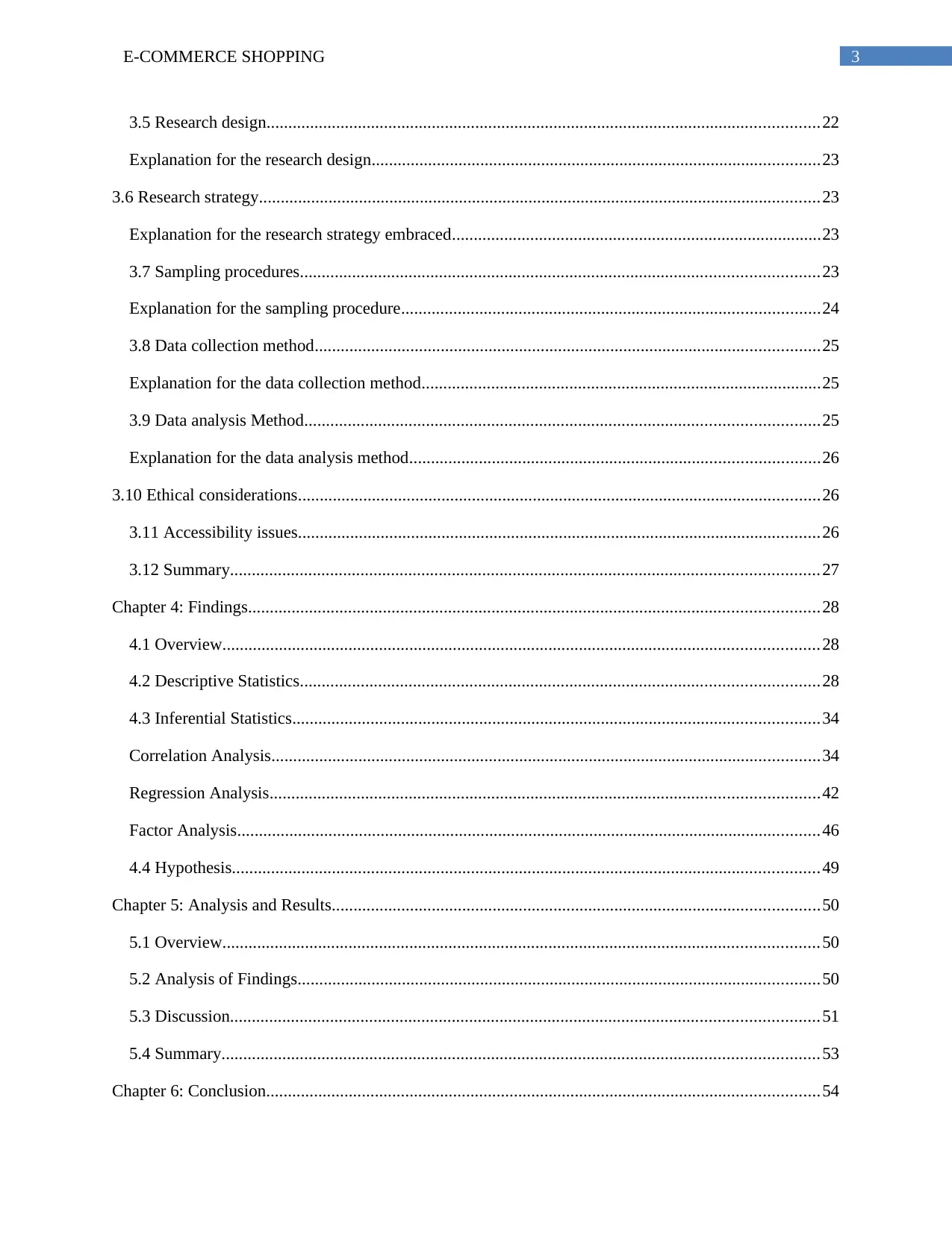
3E-COMMERCE SHOPPING
3.5 Research design...............................................................................................................................22
Explanation for the research design.......................................................................................................23
3.6 Research strategy.................................................................................................................................23
Explanation for the research strategy embraced.....................................................................................23
3.7 Sampling procedures.......................................................................................................................23
Explanation for the sampling procedure................................................................................................24
3.8 Data collection method....................................................................................................................25
Explanation for the data collection method............................................................................................25
3.9 Data analysis Method......................................................................................................................25
Explanation for the data analysis method..............................................................................................26
3.10 Ethical considerations........................................................................................................................26
3.11 Accessibility issues........................................................................................................................26
3.12 Summary.......................................................................................................................................27
Chapter 4: Findings...................................................................................................................................28
4.1 Overview.........................................................................................................................................28
4.2 Descriptive Statistics.......................................................................................................................28
4.3 Inferential Statistics.........................................................................................................................34
Correlation Analysis..............................................................................................................................34
Regression Analysis..............................................................................................................................42
Factor Analysis......................................................................................................................................46
4.4 Hypothesis.......................................................................................................................................49
Chapter 5: Analysis and Results................................................................................................................50
5.1 Overview.........................................................................................................................................50
5.2 Analysis of Findings........................................................................................................................50
5.3 Discussion.......................................................................................................................................51
5.4 Summary.........................................................................................................................................53
Chapter 6: Conclusion...............................................................................................................................54
3.5 Research design...............................................................................................................................22
Explanation for the research design.......................................................................................................23
3.6 Research strategy.................................................................................................................................23
Explanation for the research strategy embraced.....................................................................................23
3.7 Sampling procedures.......................................................................................................................23
Explanation for the sampling procedure................................................................................................24
3.8 Data collection method....................................................................................................................25
Explanation for the data collection method............................................................................................25
3.9 Data analysis Method......................................................................................................................25
Explanation for the data analysis method..............................................................................................26
3.10 Ethical considerations........................................................................................................................26
3.11 Accessibility issues........................................................................................................................26
3.12 Summary.......................................................................................................................................27
Chapter 4: Findings...................................................................................................................................28
4.1 Overview.........................................................................................................................................28
4.2 Descriptive Statistics.......................................................................................................................28
4.3 Inferential Statistics.........................................................................................................................34
Correlation Analysis..............................................................................................................................34
Regression Analysis..............................................................................................................................42
Factor Analysis......................................................................................................................................46
4.4 Hypothesis.......................................................................................................................................49
Chapter 5: Analysis and Results................................................................................................................50
5.1 Overview.........................................................................................................................................50
5.2 Analysis of Findings........................................................................................................................50
5.3 Discussion.......................................................................................................................................51
5.4 Summary.........................................................................................................................................53
Chapter 6: Conclusion...............................................................................................................................54
Paraphrase This Document
Need a fresh take? Get an instant paraphrase of this document with our AI Paraphraser

4E-COMMERCE SHOPPING
6.1 Overview.........................................................................................................................................54
6.2 Linking to Objectives......................................................................................................................55
6.3 Limitations of the study...................................................................................................................55
6.4 Future scope.....................................................................................................................................56
6.5 Recommendations...........................................................................................................................56
References.................................................................................................................................................57
Appendix...................................................................................................................................................61
Questionnaire.........................................................................................................................................61
6.1 Overview.........................................................................................................................................54
6.2 Linking to Objectives......................................................................................................................55
6.3 Limitations of the study...................................................................................................................55
6.4 Future scope.....................................................................................................................................56
6.5 Recommendations...........................................................................................................................56
References.................................................................................................................................................57
Appendix...................................................................................................................................................61
Questionnaire.........................................................................................................................................61
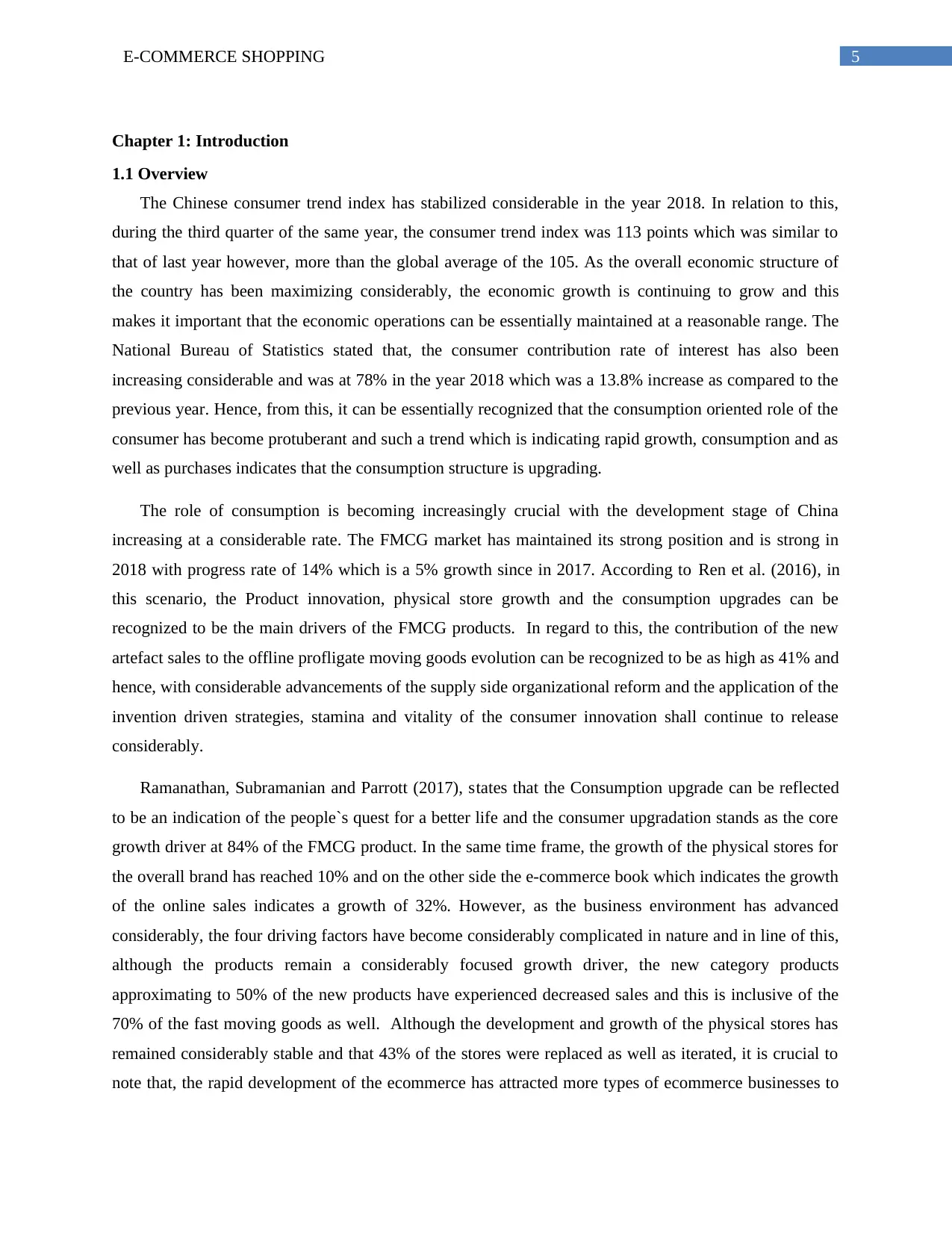
5E-COMMERCE SHOPPING
Chapter 1: Introduction
1.1 Overview
The Chinese consumer trend index has stabilized considerable in the year 2018. In relation to this,
during the third quarter of the same year, the consumer trend index was 113 points which was similar to
that of last year however, more than the global average of the 105. As the overall economic structure of
the country has been maximizing considerably, the economic growth is continuing to grow and this
makes it important that the economic operations can be essentially maintained at a reasonable range. The
National Bureau of Statistics stated that, the consumer contribution rate of interest has also been
increasing considerable and was at 78% in the year 2018 which was a 13.8% increase as compared to the
previous year. Hence, from this, it can be essentially recognized that the consumption oriented role of the
consumer has become protuberant and such a trend which is indicating rapid growth, consumption and as
well as purchases indicates that the consumption structure is upgrading.
The role of consumption is becoming increasingly crucial with the development stage of China
increasing at a considerable rate. The FMCG market has maintained its strong position and is strong in
2018 with progress rate of 14% which is a 5% growth since in 2017. According to Ren et al. (2016), in
this scenario, the Product innovation, physical store growth and the consumption upgrades can be
recognized to be the main drivers of the FMCG products. In regard to this, the contribution of the new
artefact sales to the offline profligate moving goods evolution can be recognized to be as high as 41% and
hence, with considerable advancements of the supply side organizational reform and the application of the
invention driven strategies, stamina and vitality of the consumer innovation shall continue to release
considerably.
Ramanathan, Subramanian and Parrott (2017), states that the Consumption upgrade can be reflected
to be an indication of the people`s quest for a better life and the consumer upgradation stands as the core
growth driver at 84% of the FMCG product. In the same time frame, the growth of the physical stores for
the overall brand has reached 10% and on the other side the e-commerce book which indicates the growth
of the online sales indicates a growth of 32%. However, as the business environment has advanced
considerably, the four driving factors have become considerably complicated in nature and in line of this,
although the products remain a considerably focused growth driver, the new category products
approximating to 50% of the new products have experienced decreased sales and this is inclusive of the
70% of the fast moving goods as well. Although the development and growth of the physical stores has
remained considerably stable and that 43% of the stores were replaced as well as iterated, it is crucial to
note that, the rapid development of the ecommerce has attracted more types of ecommerce businesses to
Chapter 1: Introduction
1.1 Overview
The Chinese consumer trend index has stabilized considerable in the year 2018. In relation to this,
during the third quarter of the same year, the consumer trend index was 113 points which was similar to
that of last year however, more than the global average of the 105. As the overall economic structure of
the country has been maximizing considerably, the economic growth is continuing to grow and this
makes it important that the economic operations can be essentially maintained at a reasonable range. The
National Bureau of Statistics stated that, the consumer contribution rate of interest has also been
increasing considerable and was at 78% in the year 2018 which was a 13.8% increase as compared to the
previous year. Hence, from this, it can be essentially recognized that the consumption oriented role of the
consumer has become protuberant and such a trend which is indicating rapid growth, consumption and as
well as purchases indicates that the consumption structure is upgrading.
The role of consumption is becoming increasingly crucial with the development stage of China
increasing at a considerable rate. The FMCG market has maintained its strong position and is strong in
2018 with progress rate of 14% which is a 5% growth since in 2017. According to Ren et al. (2016), in
this scenario, the Product innovation, physical store growth and the consumption upgrades can be
recognized to be the main drivers of the FMCG products. In regard to this, the contribution of the new
artefact sales to the offline profligate moving goods evolution can be recognized to be as high as 41% and
hence, with considerable advancements of the supply side organizational reform and the application of the
invention driven strategies, stamina and vitality of the consumer innovation shall continue to release
considerably.
Ramanathan, Subramanian and Parrott (2017), states that the Consumption upgrade can be reflected
to be an indication of the people`s quest for a better life and the consumer upgradation stands as the core
growth driver at 84% of the FMCG product. In the same time frame, the growth of the physical stores for
the overall brand has reached 10% and on the other side the e-commerce book which indicates the growth
of the online sales indicates a growth of 32%. However, as the business environment has advanced
considerably, the four driving factors have become considerably complicated in nature and in line of this,
although the products remain a considerably focused growth driver, the new category products
approximating to 50% of the new products have experienced decreased sales and this is inclusive of the
70% of the fast moving goods as well. Although the development and growth of the physical stores has
remained considerably stable and that 43% of the stores were replaced as well as iterated, it is crucial to
note that, the rapid development of the ecommerce has attracted more types of ecommerce businesses to
⊘ This is a preview!⊘
Do you want full access?
Subscribe today to unlock all pages.

Trusted by 1+ million students worldwide

6E-COMMERCE SHOPPING
compete accordingly and this has also lead to the involvement of the nonintegrated e-commerce users.
The e-commerce field has practiced a considerable growth rate of 194% whereas the monthly users has
increased by 22% only (Amin 2016). However, in a complex environment which is diverse in nature, it
becomes critically crucial for the business to comprehend the various trends relating to the complex and
diverse consumer environment and the trends of the people, good and fields through the medium of data
analysis is required to be recognized so as to predict the upcoming trends in the year 2019 and in line of
this driving the business and related marketing innovation.
Therefore, by gaining these insights, the brands will be able to perform in a better manner. Therefore,
this research can be recognized to be focused at the manner in which the E-commerce customer
satisfaction can take place adequately in the first tier cities in China and how the different organizations
will be able to focus on providing brand value to the different customers as present.
1.2 Problem statement
The modernization of life has made the individuals very busy and it is in regard to this that, the
medium of Internet shopping has become considerably popular and can be easily browsed and accessed
also. The most convenient aspect of the Internet shopping can be considered to be the fact that, Internet
shopping allows the different users to shop from the convenience of their homes or offices or for that
matter from any point where the network connectivity is available for the user. Not only do these online
websites allow the users with a greater variety, but also allow the different users with considerable
discounts. Therefore, due to these various advantages being offered by the particular online domain, many
students, house wife’s, office workers and other personnel like to shop online.
In contrary to this, there are considerable risks involved in the particular field of shopping which
generally tends to come in the form of the payment to be made, the quality of the items to be provided,
the delivery and other such contrary risks as present in the field. Various online sellers often tend to claim
that there exists a considerable gap between the products which are exhibited on the internet and the
beings as received by the various customers (Izogo and Ogba 2015). The origin, date of manufacturing
and other related information also tends to differ. Very often after the payment has been made, the seller
does not receive the product and has nowhere to go and therefore in such a case, there can be recognized
to be various fraudulent cases which have taken place in the particular domain. Hence, the different
online shoppers will be required to certify that they are conscious of the perils of online shopping before
they proceed with it. The e-shoppers will be required to select an excellent shopping platform and
comprehend all the existing policies which exist in such a domain. In addition to this, the evaluation of
the buyer needs to be done and in addition to this, the satisfaction level of the seller also needs to be
recognized considerably. Moreover, it is the duty of the buyer that before purchasing the product they are
compete accordingly and this has also lead to the involvement of the nonintegrated e-commerce users.
The e-commerce field has practiced a considerable growth rate of 194% whereas the monthly users has
increased by 22% only (Amin 2016). However, in a complex environment which is diverse in nature, it
becomes critically crucial for the business to comprehend the various trends relating to the complex and
diverse consumer environment and the trends of the people, good and fields through the medium of data
analysis is required to be recognized so as to predict the upcoming trends in the year 2019 and in line of
this driving the business and related marketing innovation.
Therefore, by gaining these insights, the brands will be able to perform in a better manner. Therefore,
this research can be recognized to be focused at the manner in which the E-commerce customer
satisfaction can take place adequately in the first tier cities in China and how the different organizations
will be able to focus on providing brand value to the different customers as present.
1.2 Problem statement
The modernization of life has made the individuals very busy and it is in regard to this that, the
medium of Internet shopping has become considerably popular and can be easily browsed and accessed
also. The most convenient aspect of the Internet shopping can be considered to be the fact that, Internet
shopping allows the different users to shop from the convenience of their homes or offices or for that
matter from any point where the network connectivity is available for the user. Not only do these online
websites allow the users with a greater variety, but also allow the different users with considerable
discounts. Therefore, due to these various advantages being offered by the particular online domain, many
students, house wife’s, office workers and other personnel like to shop online.
In contrary to this, there are considerable risks involved in the particular field of shopping which
generally tends to come in the form of the payment to be made, the quality of the items to be provided,
the delivery and other such contrary risks as present in the field. Various online sellers often tend to claim
that there exists a considerable gap between the products which are exhibited on the internet and the
beings as received by the various customers (Izogo and Ogba 2015). The origin, date of manufacturing
and other related information also tends to differ. Very often after the payment has been made, the seller
does not receive the product and has nowhere to go and therefore in such a case, there can be recognized
to be various fraudulent cases which have taken place in the particular domain. Hence, the different
online shoppers will be required to certify that they are conscious of the perils of online shopping before
they proceed with it. The e-shoppers will be required to select an excellent shopping platform and
comprehend all the existing policies which exist in such a domain. In addition to this, the evaluation of
the buyer needs to be done and in addition to this, the satisfaction level of the seller also needs to be
recognized considerably. Moreover, it is the duty of the buyer that before purchasing the product they are
Paraphrase This Document
Need a fresh take? Get an instant paraphrase of this document with our AI Paraphraser
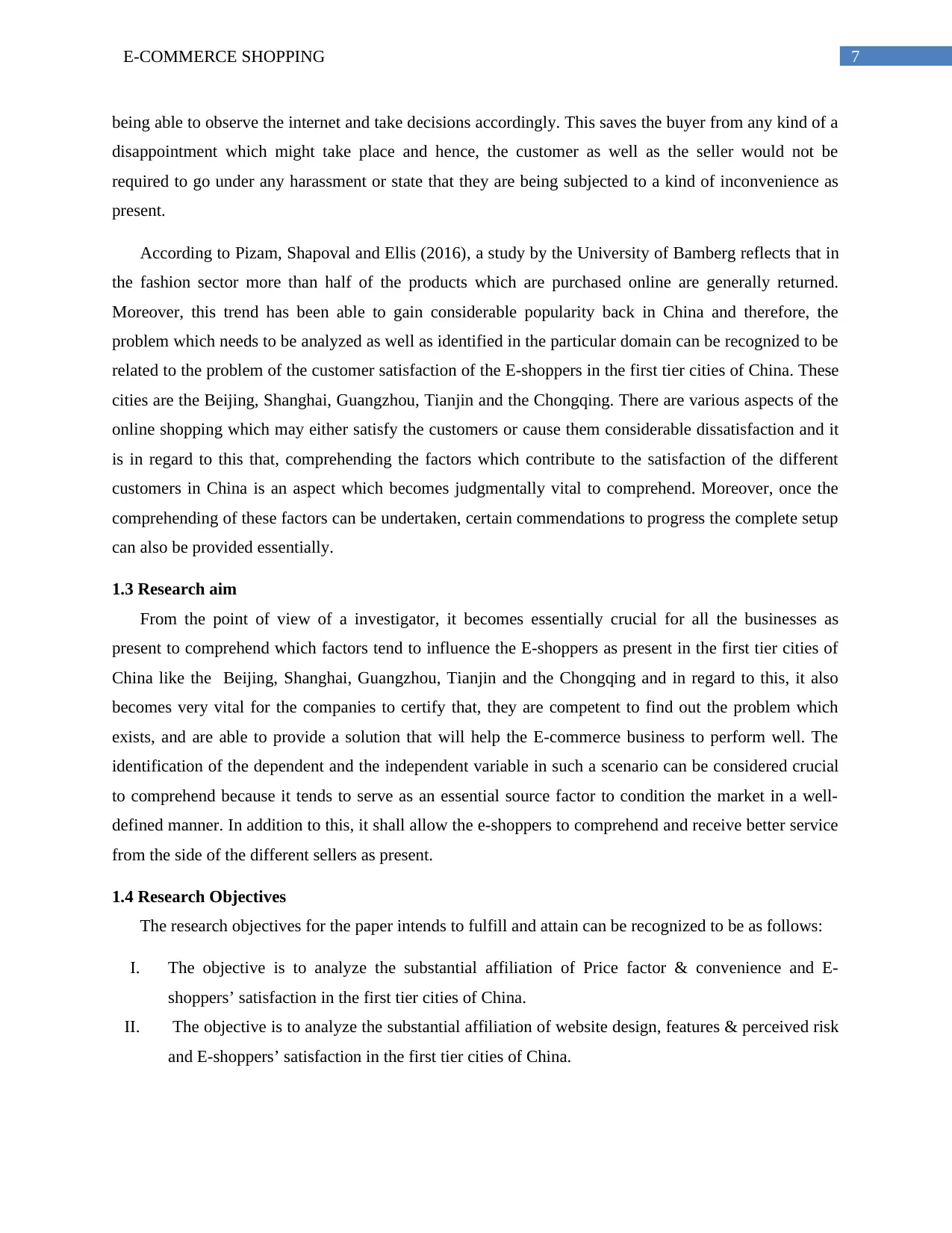
7E-COMMERCE SHOPPING
being able to observe the internet and take decisions accordingly. This saves the buyer from any kind of a
disappointment which might take place and hence, the customer as well as the seller would not be
required to go under any harassment or state that they are being subjected to a kind of inconvenience as
present.
According to Pizam, Shapoval and Ellis (2016), a study by the University of Bamberg reflects that in
the fashion sector more than half of the products which are purchased online are generally returned.
Moreover, this trend has been able to gain considerable popularity back in China and therefore, the
problem which needs to be analyzed as well as identified in the particular domain can be recognized to be
related to the problem of the customer satisfaction of the E-shoppers in the first tier cities of China. These
cities are the Beijing, Shanghai, Guangzhou, Tianjin and the Chongqing. There are various aspects of the
online shopping which may either satisfy the customers or cause them considerable dissatisfaction and it
is in regard to this that, comprehending the factors which contribute to the satisfaction of the different
customers in China is an aspect which becomes judgmentally vital to comprehend. Moreover, once the
comprehending of these factors can be undertaken, certain commendations to progress the complete setup
can also be provided essentially.
1.3 Research aim
From the point of view of a investigator, it becomes essentially crucial for all the businesses as
present to comprehend which factors tend to influence the E-shoppers as present in the first tier cities of
China like the Beijing, Shanghai, Guangzhou, Tianjin and the Chongqing and in regard to this, it also
becomes very vital for the companies to certify that, they are competent to find out the problem which
exists, and are able to provide a solution that will help the E-commerce business to perform well. The
identification of the dependent and the independent variable in such a scenario can be considered crucial
to comprehend because it tends to serve as an essential source factor to condition the market in a well-
defined manner. In addition to this, it shall allow the e-shoppers to comprehend and receive better service
from the side of the different sellers as present.
1.4 Research Objectives
The research objectives for the paper intends to fulfill and attain can be recognized to be as follows:
I. The objective is to analyze the substantial affiliation of Price factor & convenience and E-
shoppers’ satisfaction in the first tier cities of China.
II. The objective is to analyze the substantial affiliation of website design, features & perceived risk
and E-shoppers’ satisfaction in the first tier cities of China.
being able to observe the internet and take decisions accordingly. This saves the buyer from any kind of a
disappointment which might take place and hence, the customer as well as the seller would not be
required to go under any harassment or state that they are being subjected to a kind of inconvenience as
present.
According to Pizam, Shapoval and Ellis (2016), a study by the University of Bamberg reflects that in
the fashion sector more than half of the products which are purchased online are generally returned.
Moreover, this trend has been able to gain considerable popularity back in China and therefore, the
problem which needs to be analyzed as well as identified in the particular domain can be recognized to be
related to the problem of the customer satisfaction of the E-shoppers in the first tier cities of China. These
cities are the Beijing, Shanghai, Guangzhou, Tianjin and the Chongqing. There are various aspects of the
online shopping which may either satisfy the customers or cause them considerable dissatisfaction and it
is in regard to this that, comprehending the factors which contribute to the satisfaction of the different
customers in China is an aspect which becomes judgmentally vital to comprehend. Moreover, once the
comprehending of these factors can be undertaken, certain commendations to progress the complete setup
can also be provided essentially.
1.3 Research aim
From the point of view of a investigator, it becomes essentially crucial for all the businesses as
present to comprehend which factors tend to influence the E-shoppers as present in the first tier cities of
China like the Beijing, Shanghai, Guangzhou, Tianjin and the Chongqing and in regard to this, it also
becomes very vital for the companies to certify that, they are competent to find out the problem which
exists, and are able to provide a solution that will help the E-commerce business to perform well. The
identification of the dependent and the independent variable in such a scenario can be considered crucial
to comprehend because it tends to serve as an essential source factor to condition the market in a well-
defined manner. In addition to this, it shall allow the e-shoppers to comprehend and receive better service
from the side of the different sellers as present.
1.4 Research Objectives
The research objectives for the paper intends to fulfill and attain can be recognized to be as follows:
I. The objective is to analyze the substantial affiliation of Price factor & convenience and E-
shoppers’ satisfaction in the first tier cities of China.
II. The objective is to analyze the substantial affiliation of website design, features & perceived risk
and E-shoppers’ satisfaction in the first tier cities of China.

8E-COMMERCE SHOPPING
1.5 Research Questions
Saunders and Townsend (2016), state that a research question needs to be such which will intend to
provide a clear explanation in regard to the information which the investigator is required to attain and
therefore, in regard to this, the Research questions need to be prepared and defined in a manner such that,
they are able to guide the Literature review considerably and additionally, they are also able to determine
the research design to be used and also act as a determinant of the method in which the data for the
research is composed and how the analysis of the same will take place. Hence, the investigator in the
particular research has aimed at identifying appropriate research questions for the domain as follows:
i) How does price factors and convenience influence E-shoppers satisfaction in the first tier
cities of China?
ii) How does website design, features & perceived risks influence E-shoppers satisfaction in the
first tier cities of China?
1.6 Research Hypothesis
The research hypothesis helps in determining whether the assumption is true which has been obtained
in regard to the research. In line of this, it is important to set a hypothesis in a research as it helps to
collect the data, undertake the analysis of the same and to achieve the overall objectives of the study. The
procedure of hypothesis collection and identification can be stated to be as follows:
1. Setting the null and the alternate hypothesis
2. This is followed by the collection of the data
3. Judging whether to accept the null hypothesis or to reject it with the help of the Critical value and
the P-value.
Note: H0 - null hypothesis H1 - alternative hypothesis
The hypothesis which has been prepared for the research can be recognized to be as follows:
Hypothesis 1
H0: There is no substantial affiliation between price factor & convenience and E-shoppers satisfaction in
the first tier cities China
H1: There is substantial affiliation between price factor & convenience and E-shoppers satisfaction in the
first tier cities of China
Hypothesis 2
1.5 Research Questions
Saunders and Townsend (2016), state that a research question needs to be such which will intend to
provide a clear explanation in regard to the information which the investigator is required to attain and
therefore, in regard to this, the Research questions need to be prepared and defined in a manner such that,
they are able to guide the Literature review considerably and additionally, they are also able to determine
the research design to be used and also act as a determinant of the method in which the data for the
research is composed and how the analysis of the same will take place. Hence, the investigator in the
particular research has aimed at identifying appropriate research questions for the domain as follows:
i) How does price factors and convenience influence E-shoppers satisfaction in the first tier
cities of China?
ii) How does website design, features & perceived risks influence E-shoppers satisfaction in the
first tier cities of China?
1.6 Research Hypothesis
The research hypothesis helps in determining whether the assumption is true which has been obtained
in regard to the research. In line of this, it is important to set a hypothesis in a research as it helps to
collect the data, undertake the analysis of the same and to achieve the overall objectives of the study. The
procedure of hypothesis collection and identification can be stated to be as follows:
1. Setting the null and the alternate hypothesis
2. This is followed by the collection of the data
3. Judging whether to accept the null hypothesis or to reject it with the help of the Critical value and
the P-value.
Note: H0 - null hypothesis H1 - alternative hypothesis
The hypothesis which has been prepared for the research can be recognized to be as follows:
Hypothesis 1
H0: There is no substantial affiliation between price factor & convenience and E-shoppers satisfaction in
the first tier cities China
H1: There is substantial affiliation between price factor & convenience and E-shoppers satisfaction in the
first tier cities of China
Hypothesis 2
⊘ This is a preview!⊘
Do you want full access?
Subscribe today to unlock all pages.

Trusted by 1+ million students worldwide
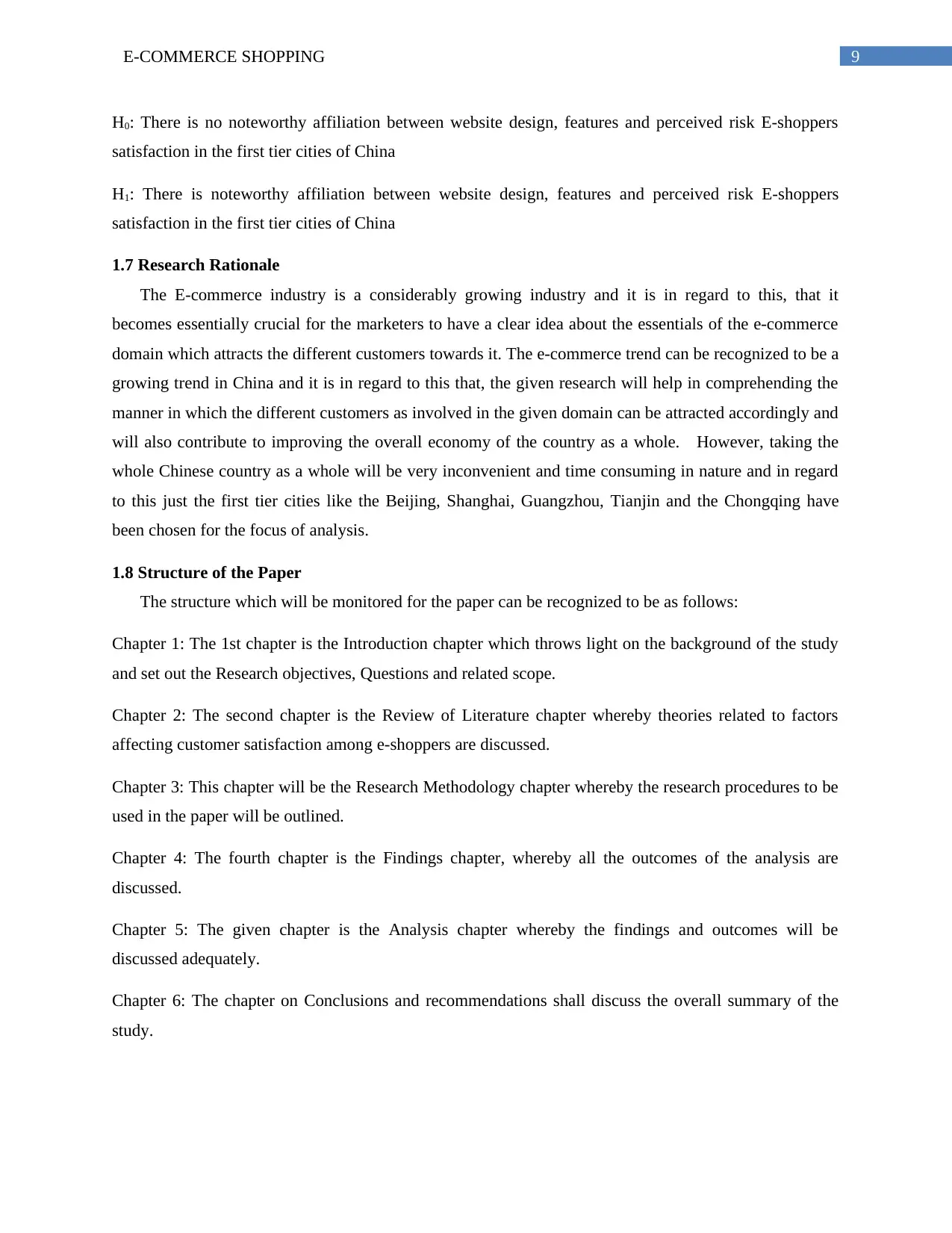
9E-COMMERCE SHOPPING
H0: There is no noteworthy affiliation between website design, features and perceived risk E-shoppers
satisfaction in the first tier cities of China
H1: There is noteworthy affiliation between website design, features and perceived risk E-shoppers
satisfaction in the first tier cities of China
1.7 Research Rationale
The E-commerce industry is a considerably growing industry and it is in regard to this, that it
becomes essentially crucial for the marketers to have a clear idea about the essentials of the e-commerce
domain which attracts the different customers towards it. The e-commerce trend can be recognized to be a
growing trend in China and it is in regard to this that, the given research will help in comprehending the
manner in which the different customers as involved in the given domain can be attracted accordingly and
will also contribute to improving the overall economy of the country as a whole. However, taking the
whole Chinese country as a whole will be very inconvenient and time consuming in nature and in regard
to this just the first tier cities like the Beijing, Shanghai, Guangzhou, Tianjin and the Chongqing have
been chosen for the focus of analysis.
1.8 Structure of the Paper
The structure which will be monitored for the paper can be recognized to be as follows:
Chapter 1: The 1st chapter is the Introduction chapter which throws light on the background of the study
and set out the Research objectives, Questions and related scope.
Chapter 2: The second chapter is the Review of Literature chapter whereby theories related to factors
affecting customer satisfaction among e-shoppers are discussed.
Chapter 3: This chapter will be the Research Methodology chapter whereby the research procedures to be
used in the paper will be outlined.
Chapter 4: The fourth chapter is the Findings chapter, whereby all the outcomes of the analysis are
discussed.
Chapter 5: The given chapter is the Analysis chapter whereby the findings and outcomes will be
discussed adequately.
Chapter 6: The chapter on Conclusions and recommendations shall discuss the overall summary of the
study.
H0: There is no noteworthy affiliation between website design, features and perceived risk E-shoppers
satisfaction in the first tier cities of China
H1: There is noteworthy affiliation between website design, features and perceived risk E-shoppers
satisfaction in the first tier cities of China
1.7 Research Rationale
The E-commerce industry is a considerably growing industry and it is in regard to this, that it
becomes essentially crucial for the marketers to have a clear idea about the essentials of the e-commerce
domain which attracts the different customers towards it. The e-commerce trend can be recognized to be a
growing trend in China and it is in regard to this that, the given research will help in comprehending the
manner in which the different customers as involved in the given domain can be attracted accordingly and
will also contribute to improving the overall economy of the country as a whole. However, taking the
whole Chinese country as a whole will be very inconvenient and time consuming in nature and in regard
to this just the first tier cities like the Beijing, Shanghai, Guangzhou, Tianjin and the Chongqing have
been chosen for the focus of analysis.
1.8 Structure of the Paper
The structure which will be monitored for the paper can be recognized to be as follows:
Chapter 1: The 1st chapter is the Introduction chapter which throws light on the background of the study
and set out the Research objectives, Questions and related scope.
Chapter 2: The second chapter is the Review of Literature chapter whereby theories related to factors
affecting customer satisfaction among e-shoppers are discussed.
Chapter 3: This chapter will be the Research Methodology chapter whereby the research procedures to be
used in the paper will be outlined.
Chapter 4: The fourth chapter is the Findings chapter, whereby all the outcomes of the analysis are
discussed.
Chapter 5: The given chapter is the Analysis chapter whereby the findings and outcomes will be
discussed adequately.
Chapter 6: The chapter on Conclusions and recommendations shall discuss the overall summary of the
study.
Paraphrase This Document
Need a fresh take? Get an instant paraphrase of this document with our AI Paraphraser

10E-COMMERCE SHOPPING
Chapter 2: Literature Review
2.1 Overview
The e-commerce industry can be recognized to be blooming in China and this can be considered
to be because of a variety of reasons. These reasons might be the convenience provided to the different
customers, the ease of shopping, and the price discounts or may be the large variety which is provided to
the different customers (Lim et al. 2016). Hence, to comprehend the factors influencing the consumer
satisfaction in online shoppers in China, it becomes particularly crucial for the firms to certify that they
are able to comprehend what factors have an influence on the online shopping of the different customers
as present in the country and in line with this, it also becomes critical for the firms to comprehend the
manner in which they will be able to appeal to the different customers as present. Therefore, the primary
focus of this review of Literature will essentially lie on the concept of Customer Satisfaction and the
Factors influencing online shopping in the different customers as present in China (Pappas et al. 2016). In
addition to this, a conceptual framework will also be presented at the end of the chapter which will help in
comprehending the underlying affiliation between the different purchasing decisions of the customers and
the satisfaction of the customers as present.
2.2 E-commerce shopping
The China can be recognized to be one of the world`s main E-commerce market by the business
value and by the end of 2015 it took over the European Union and the United States in terms of actual
online revenues and services which take place. In addition to this, the overall E-commerce infrastructure
has improved noticeably in the recent years and the sales potential has also appeared to be limitless
(Hong, Tam and Yim 2016). According to Goldman Sachs, 75% of the China`s 467 million online
shoppers can be recognized to be the Urban Millennials in most of the top tiered cities as present. By
2020, it has been predicted that this number will be expected to increase by 200 million new shoppers, 71
% of whom will come from the lower tiered cities and hence, in lieu of this, the number will reach to
more than 670 million shoppers. The sales of these countries will then increase to USD 1.7 trillion.
Additionally, according to Lim et al. (2016), the different shoppers as present in China, spend around
US$ 1300 every year and as the income level has been increasing, this amount has been recognized to
grow substantially and the categories of the consumer goods which have been purchased will also
increase accordingly. Therefore, in the following section, the different factors which impact the online
shopping as embraced by the different customers will be recognized and in a manner similar to this, each
of these factors will be critically discussed and assessed to comprehend the manner in which they have an
impact of the online clothes shopping of the customers in China (Pappas et al. 2016).
Chapter 2: Literature Review
2.1 Overview
The e-commerce industry can be recognized to be blooming in China and this can be considered
to be because of a variety of reasons. These reasons might be the convenience provided to the different
customers, the ease of shopping, and the price discounts or may be the large variety which is provided to
the different customers (Lim et al. 2016). Hence, to comprehend the factors influencing the consumer
satisfaction in online shoppers in China, it becomes particularly crucial for the firms to certify that they
are able to comprehend what factors have an influence on the online shopping of the different customers
as present in the country and in line with this, it also becomes critical for the firms to comprehend the
manner in which they will be able to appeal to the different customers as present. Therefore, the primary
focus of this review of Literature will essentially lie on the concept of Customer Satisfaction and the
Factors influencing online shopping in the different customers as present in China (Pappas et al. 2016). In
addition to this, a conceptual framework will also be presented at the end of the chapter which will help in
comprehending the underlying affiliation between the different purchasing decisions of the customers and
the satisfaction of the customers as present.
2.2 E-commerce shopping
The China can be recognized to be one of the world`s main E-commerce market by the business
value and by the end of 2015 it took over the European Union and the United States in terms of actual
online revenues and services which take place. In addition to this, the overall E-commerce infrastructure
has improved noticeably in the recent years and the sales potential has also appeared to be limitless
(Hong, Tam and Yim 2016). According to Goldman Sachs, 75% of the China`s 467 million online
shoppers can be recognized to be the Urban Millennials in most of the top tiered cities as present. By
2020, it has been predicted that this number will be expected to increase by 200 million new shoppers, 71
% of whom will come from the lower tiered cities and hence, in lieu of this, the number will reach to
more than 670 million shoppers. The sales of these countries will then increase to USD 1.7 trillion.
Additionally, according to Lim et al. (2016), the different shoppers as present in China, spend around
US$ 1300 every year and as the income level has been increasing, this amount has been recognized to
grow substantially and the categories of the consumer goods which have been purchased will also
increase accordingly. Therefore, in the following section, the different factors which impact the online
shopping as embraced by the different customers will be recognized and in a manner similar to this, each
of these factors will be critically discussed and assessed to comprehend the manner in which they have an
impact of the online clothes shopping of the customers in China (Pappas et al. 2016).
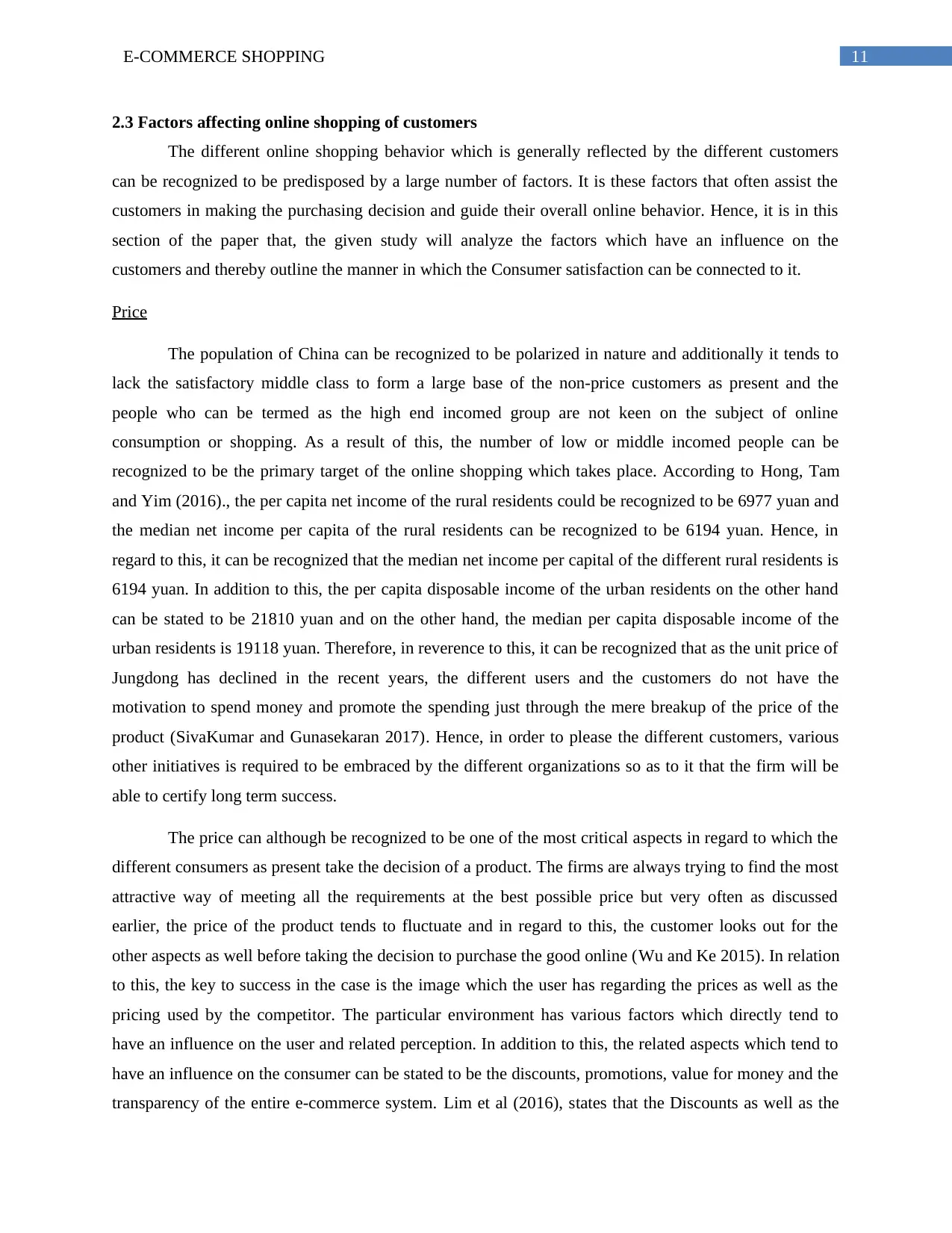
11E-COMMERCE SHOPPING
2.3 Factors affecting online shopping of customers
The different online shopping behavior which is generally reflected by the different customers
can be recognized to be predisposed by a large number of factors. It is these factors that often assist the
customers in making the purchasing decision and guide their overall online behavior. Hence, it is in this
section of the paper that, the given study will analyze the factors which have an influence on the
customers and thereby outline the manner in which the Consumer satisfaction can be connected to it.
Price
The population of China can be recognized to be polarized in nature and additionally it tends to
lack the satisfactory middle class to form a large base of the non-price customers as present and the
people who can be termed as the high end incomed group are not keen on the subject of online
consumption or shopping. As a result of this, the number of low or middle incomed people can be
recognized to be the primary target of the online shopping which takes place. According to Hong, Tam
and Yim (2016)., the per capita net income of the rural residents could be recognized to be 6977 yuan and
the median net income per capita of the rural residents can be recognized to be 6194 yuan. Hence, in
regard to this, it can be recognized that the median net income per capital of the different rural residents is
6194 yuan. In addition to this, the per capita disposable income of the urban residents on the other hand
can be stated to be 21810 yuan and on the other hand, the median per capita disposable income of the
urban residents is 19118 yuan. Therefore, in reverence to this, it can be recognized that as the unit price of
Jungdong has declined in the recent years, the different users and the customers do not have the
motivation to spend money and promote the spending just through the mere breakup of the price of the
product (SivaKumar and Gunasekaran 2017). Hence, in order to please the different customers, various
other initiatives is required to be embraced by the different organizations so as to it that the firm will be
able to certify long term success.
The price can although be recognized to be one of the most critical aspects in regard to which the
different consumers as present take the decision of a product. The firms are always trying to find the most
attractive way of meeting all the requirements at the best possible price but very often as discussed
earlier, the price of the product tends to fluctuate and in regard to this, the customer looks out for the
other aspects as well before taking the decision to purchase the good online (Wu and Ke 2015). In relation
to this, the key to success in the case is the image which the user has regarding the prices as well as the
pricing used by the competitor. The particular environment has various factors which directly tend to
have an influence on the user and related perception. In addition to this, the related aspects which tend to
have an influence on the consumer can be stated to be the discounts, promotions, value for money and the
transparency of the entire e-commerce system. Lim et al (2016), states that the Discounts as well as the
2.3 Factors affecting online shopping of customers
The different online shopping behavior which is generally reflected by the different customers
can be recognized to be predisposed by a large number of factors. It is these factors that often assist the
customers in making the purchasing decision and guide their overall online behavior. Hence, it is in this
section of the paper that, the given study will analyze the factors which have an influence on the
customers and thereby outline the manner in which the Consumer satisfaction can be connected to it.
Price
The population of China can be recognized to be polarized in nature and additionally it tends to
lack the satisfactory middle class to form a large base of the non-price customers as present and the
people who can be termed as the high end incomed group are not keen on the subject of online
consumption or shopping. As a result of this, the number of low or middle incomed people can be
recognized to be the primary target of the online shopping which takes place. According to Hong, Tam
and Yim (2016)., the per capita net income of the rural residents could be recognized to be 6977 yuan and
the median net income per capita of the rural residents can be recognized to be 6194 yuan. Hence, in
regard to this, it can be recognized that the median net income per capital of the different rural residents is
6194 yuan. In addition to this, the per capita disposable income of the urban residents on the other hand
can be stated to be 21810 yuan and on the other hand, the median per capita disposable income of the
urban residents is 19118 yuan. Therefore, in reverence to this, it can be recognized that as the unit price of
Jungdong has declined in the recent years, the different users and the customers do not have the
motivation to spend money and promote the spending just through the mere breakup of the price of the
product (SivaKumar and Gunasekaran 2017). Hence, in order to please the different customers, various
other initiatives is required to be embraced by the different organizations so as to it that the firm will be
able to certify long term success.
The price can although be recognized to be one of the most critical aspects in regard to which the
different consumers as present take the decision of a product. The firms are always trying to find the most
attractive way of meeting all the requirements at the best possible price but very often as discussed
earlier, the price of the product tends to fluctuate and in regard to this, the customer looks out for the
other aspects as well before taking the decision to purchase the good online (Wu and Ke 2015). In relation
to this, the key to success in the case is the image which the user has regarding the prices as well as the
pricing used by the competitor. The particular environment has various factors which directly tend to
have an influence on the user and related perception. In addition to this, the related aspects which tend to
have an influence on the consumer can be stated to be the discounts, promotions, value for money and the
transparency of the entire e-commerce system. Lim et al (2016), states that the Discounts as well as the
⊘ This is a preview!⊘
Do you want full access?
Subscribe today to unlock all pages.

Trusted by 1+ million students worldwide
1 out of 67
Related Documents
Your All-in-One AI-Powered Toolkit for Academic Success.
+13062052269
info@desklib.com
Available 24*7 on WhatsApp / Email
![[object Object]](/_next/static/media/star-bottom.7253800d.svg)
Unlock your academic potential
Copyright © 2020–2025 A2Z Services. All Rights Reserved. Developed and managed by ZUCOL.





